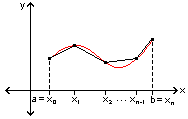Arc Length

Suppose f is continuously differentiable on the interval [a,b].
Let's derive a formula for the length L of the curve on the
interval, called the arc length over [a,b].
We'll start by subdividing the interval [a,b] into n subintervals
[x0, x1],
[x1, x2],
... ,
[xn-1,xn] where
a = x0 < x1 < … < xn-1 < xn = b.

Introduce the line segments between
(x0, f(x0)) and
(x1,f(x1)),
(x1, f(x1)) and
(x2, f(x2)),
...,
(xn-1, f(xn-1)) and
(xn, f(xn)).
The resulting polygonal path approximates the curve given by y = f(x),
and its length approximates the arc length of f(x) over [a,b].

Let's find the length of the polygonal path by adding up the lengths
of the individual line segments. The kth line segment is the
hypotenuse of a triangle with base Δxk and height
f(xk)-f(xk-1) and so has length
Lk = |
___________________
√ (Δxk)2+[f(xk)-f(xk-1)]2. |
By the Mean Value Theorem
there exists xk* ∈
[xk-1,xk] such that
Let f(x) be continuously differentiable on [a,b]. Then the arc
length L of f(x) over [a,b] is given by
Similarly, if x = g(y) with g continuously differentiable on
[c,d], then the arc length L of g(y) over [c,d] is given by
These integrals often can only be computed using numerical methods.
Key Concepts [index]
Let f(x) be continuously differentiable on [a,b]. Then the arc
length L of f(x) over [a,b] is given by
|
L = | ⌠
⌡ |
b
a
|
_________
√
1+[f ′(x)]2 |
dx |
Similarly, if x = g(y) with g continuously differentiable on
[c,d], then the arc length L of g(y) over [c,d] is given by
|
L = | ⌠
⌡ |
d
c
|
_________
√
1+[g ′(y)]2 |
dy |